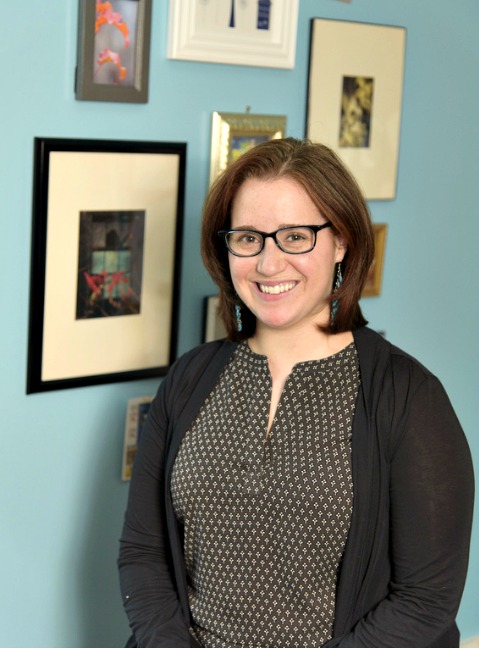Why art?
"The arts help us make meaning in the world. We express ourselves through the arts, we connect with others, we support others' questions. As artists we create culture even as culture creates us."
Using art to teach art teachers
Art and teaching overlap: "Teaching is a creative act. In making art, artists sensitively tune media, content, and composition in relationship to one another. In teaching we do the same thing, we put our knowledge of curriculum, artistic development, student interests and abilities into relationship with each other even as we build connections with students."
Saturday Art School on campus: "After teaching children weekly at our Saturday Art School, teacher candidates write about their teaching philosophy and make a visual work to represent it. I get paintings, sculptures, ceramics — whatever language they're experts in."
Background and expertise
Arts educator since 2005, at Naz since 2014: "I've taught visual art in public and private schools, in extra-curricular settings, and in after-school programs. As an undergrad, I double-majored in art education and dance, so I also have 10 years of dance teaching experience, pre-K to grade 12. I'm an arts educator, not just a visual art educator. So I bring interest and dedication to the importance of all of the arts in our lives to my teaching."
Personal experience drives research focus: "I was a top student, winning awards in art, sailed through student teaching, had lots of teaching experience — and yet I almost quit my first year as an art teacher. Teaching requires so many skills and tasks, and you can feel isolated. Intersecting with the real lives, ideas, and energies of young people is complex and unpredictable, which is teaching's challenge and its strength. In graduate school, my research focused on the challenges that face new art teachers. It's clear that strong classroom management and organization skills, combined with strong theoretical foundations, are critical."
Preparing Naz students to be changemakers
Our students in art and design programs learn about and develop the skills needed to be changemakers, including perseverance, empathy, global citizenship, inclusivity, self-awareness, well-being, and believing in the possibility of positive change.
Just one example: Creative processes, by their very nature, are ambiguous, and our students learn to engage and persevere through artistic media and written language, and students learn how other artists and academics have done so. Art education teacher candidates write a teaching philosophy, and they reflect on experiences during Saturday Art School and student teaching, both identifying things that have gone well and what they will "try tomorrow."
Courses I teach:
- Graduate Capstone: Artist-Teacher/Researcher Identities
- Arts Across the Curriculum
- Qualitative Research Methods
- Issues in Art Education
- Saturday Art School
- Introduction to Curriculum Theory and Lesson Planning
- Foundations of Learning in the Arts
- PEQ: How to Be An Explorer of the World
Favorite class: "Right now my favorite class is Qualitative Research Methods, where students research topics such as visible tattoos in the workplace, iPads in the classroom, color and gender in nursery designs, how teachers are using Pinterest as a planning tool, and sequential art as pedagogy."
Teaching philosophy
"I believe that education is about becoming comfortable with the search for meaning and understanding, and the ambiguity that is inherent in that search. I also believe that teaching and learning happen in the body — our movements, our encounters, and our (inter)actions all create possibilities to bring what's inside us into contact with the outside. Such thresholds of encounter happen to us when we go places, learn new skills, interact with other people, and make things. I think about teaching as something where my task is to facilitate opportunities for students to reflect and express their ideas and understandings that come from these encounters."
Why Naz?
Liberal arts is fundamental: "Naz has an excellent liberal arts program that structures itself around big ideas and essential/enduring questions that also are at the heart of contemporary art education practices. This means that students are personally learning in ways they will be asked to conceive of for units of instruction later. A liberal arts education is also fundamental for understanding the arts in context with history, culture, and society. Art does not exist in a vacuum and neither should an education in the arts.
Develop as artist and teacher: The Art and Design Department will help you build strong foundations in technique and composition as well as a voice in your work."

"Our students work with talented professional artists and art educators who are experts in their chosen media, but are also experienced and dedicated teachers."
Her tips for students interested in this field
- Pay attention to your most effective teachers and the least so. What do they do that helps you most as a student?
- Develop your art technique, especially drawing.
- Develop your ideas. Art is about speaking back to, and in dialogue with, the world. What do you want to think about and say?
“She’s so willing to give support, advice, help with research, and to make connections for us. She’s energetic, enthusiastic, and overall makes it a fun experience. It makes it easy to remember the lessons.” — Emily Richmond ‘16G
Fun fact
She's a die-hard science fiction geek.
“She’s very approachable. She makes everything very relevant to us and shares her personal experience as an art teacher. I feel prepared to create lessons, gather materials, create visuals to present, and to be adaptable.” — Amanda Wilmier ‘15, ‘16G
Proud moment
Won a national dissertation award in 2016 for her research, given by the Arts and Learning Special Interest Group of the American Education Research Association.
More
For her own artwork and more about her teaching, see Samantha Nolte-Yupari's personal website.
Faculty Spotlights
Wondering who else you can learn from — and who will support and challenge you? Check out Faculty Spotlights.